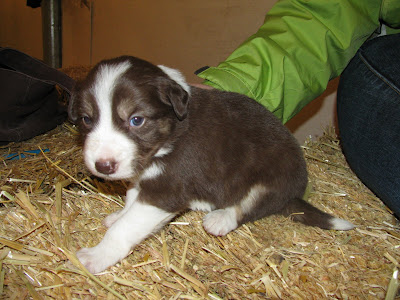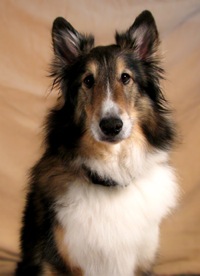Following is a brief educational explanation (ie. rant) of basic dog color. Specifically brown versus red. There are two basic forms of pigmentation that a dog can make: Eumelanin (black) and phaeomelanin (red). Each pigment can be altered, made more dilute or more intense, but the base pigment type is always the same. So red can become yellow, gold, cream, or tan, while black can become brown, grey, or blue.
Let me focus for a moment on "brown". Brown is controlled by the Tyrosinase Related Protein 1 gene and is inherited in a recessive fashion. That means that two copies of a mutated form of the gene must be present in order for an effect to be seen. That effect is the dilution of black pigment to a brown color. "Brown" only affects eumelanin pigment, and when two copies of the mutation are present, will effect ALL eumelanin pigment on the dog's body. This includes hair pigment and leather pigment (nose, paw pads, eye rims, lips, etc.). To that effect, since ALL black pigment is changed to brown, it is IMPOSSIBLE for a dog to express BOTH black AND brown at the same time. Think about that for a minute ... a dog CANNOT be "black and brown". Impossible, not gonna happen, try again!
Here are some examples of BROWN dogs ...
And now for some dogs that are commonly called "black and brown", but are NOT BROWN! Pay attention now, see if you can notice what separates these NOT BROWN dogs from the brown dogs above.
 Everyone is familiar with "black and tan", like in Doberman Pinschers, Rottweilers, etc. "Tan" is a form of red. So technically this dog is black and red.
Everyone is familiar with "black and tan", like in Doberman Pinschers, Rottweilers, etc. "Tan" is a form of red. So technically this dog is black and red.  Another form of "sable". Red and black.
Another form of "sable". Red and black. In some breeds, this is called "wheaton". Again, a pale red and black.
In some breeds, this is called "wheaton". Again, a pale red and black. I'll give this one to you, the light parts on this dog LOOK like they could be brown. But notice all the black ... she cannot be brown and black. Brindle dogs, like this one, are always stripes of eumelanin and phaeomelanin, in this case it is black and red.
I'll give this one to you, the light parts on this dog LOOK like they could be brown. But notice all the black ... she cannot be brown and black. Brindle dogs, like this one, are always stripes of eumelanin and phaeomelanin, in this case it is black and red. Another brindle. Red and black.
Another brindle. Red and black. This Great Dane is what is sometimes referred to as "fawnequin". Harlequin is the more well known color, the same pattern on a black dog. This is the harlequin pattern on a fawn dog. Red and black.
This Great Dane is what is sometimes referred to as "fawnequin". Harlequin is the more well known color, the same pattern on a black dog. This is the harlequin pattern on a fawn dog. Red and black. Doberman Pinschers and Rottweilers are not the only black and tan dogs. Add white to the mix, and you can get "tri-color" dogs like this Jack Russel. Again, red and black, this time with white.
Doberman Pinschers and Rottweilers are not the only black and tan dogs. Add white to the mix, and you can get "tri-color" dogs like this Jack Russel. Again, red and black, this time with white. This Sheltie pup is sable. Sable is RED, not brown.
This Sheltie pup is sable. Sable is RED, not brown.  I suspect this handsome fellow is recessive red. Not sable like some of the above dogs. But still, no brown.
I suspect this handsome fellow is recessive red. Not sable like some of the above dogs. But still, no brown. And yet another "sable" dog. Red and black, no brown.
And yet another "sable" dog. Red and black, no brown.So, did you see the difference between the brown dogs and the not-brown dogs? Go back and look again, I'll give you a minute.
Did you see it now?
Did you see it now?
THE NOSE!!
Brown dogs will ALWAYS have a brown nose. If the nose is black, then the dog CANNOT be brown! Go look again, I'm not lying to you.
Now here are some tricky ones ...
 This dog is "saddle tan", which is a red dog with a dark patch of eumelanin on their back, sort of like a horse's saddle. In this case, the dog is also brown! So all of the black that would normally be on her saddle area, ears, and face has been changed to brown. So she is red and brown, instead of red and black.
This dog is "saddle tan", which is a red dog with a dark patch of eumelanin on their back, sort of like a horse's saddle. In this case, the dog is also brown! So all of the black that would normally be on her saddle area, ears, and face has been changed to brown. So she is red and brown, instead of red and black.
 This is a Nova Scotia Duck Tolling Retriever. They are all this color, which is recessive red caused by a mutation in the Melanocortin 1 Receptor gene. That mutation means that it is impossible for the dog to produce any black pigment in their hair. Normally, the dog would be able to produce black "leather" pigment, so their nose and paw pads would be black. But in this case, in addition to being recessive red, the dog is also brown. So his body coat is all red, while his leather is brown in color.
This is a Nova Scotia Duck Tolling Retriever. They are all this color, which is recessive red caused by a mutation in the Melanocortin 1 Receptor gene. That mutation means that it is impossible for the dog to produce any black pigment in their hair. Normally, the dog would be able to produce black "leather" pigment, so their nose and paw pads would be black. But in this case, in addition to being recessive red, the dog is also brown. So his body coat is all red, while his leather is brown in color.
Brown dogs will ALWAYS have a brown nose. If the nose is black, then the dog CANNOT be brown! Go look again, I'm not lying to you.
Now here are some tricky ones ...
 This dog is "saddle tan", which is a red dog with a dark patch of eumelanin on their back, sort of like a horse's saddle. In this case, the dog is also brown! So all of the black that would normally be on her saddle area, ears, and face has been changed to brown. So she is red and brown, instead of red and black.
This dog is "saddle tan", which is a red dog with a dark patch of eumelanin on their back, sort of like a horse's saddle. In this case, the dog is also brown! So all of the black that would normally be on her saddle area, ears, and face has been changed to brown. So she is red and brown, instead of red and black. This is a Nova Scotia Duck Tolling Retriever. They are all this color, which is recessive red caused by a mutation in the Melanocortin 1 Receptor gene. That mutation means that it is impossible for the dog to produce any black pigment in their hair. Normally, the dog would be able to produce black "leather" pigment, so their nose and paw pads would be black. But in this case, in addition to being recessive red, the dog is also brown. So his body coat is all red, while his leather is brown in color.
This is a Nova Scotia Duck Tolling Retriever. They are all this color, which is recessive red caused by a mutation in the Melanocortin 1 Receptor gene. That mutation means that it is impossible for the dog to produce any black pigment in their hair. Normally, the dog would be able to produce black "leather" pigment, so their nose and paw pads would be black. But in this case, in addition to being recessive red, the dog is also brown. So his body coat is all red, while his leather is brown in color.










4 comments:
As I was scrolling through your post I wondered if I'd see a "Rhodesian Ridgeback" in the mix, and there he was...and I agree he is very handsome. Actually as I was reading I was wondering where Monty fits into the pack. And without knowing any of the science behind his color, I always refer to him as red, or reddish-brown but I never refer to him as brown as many other people do. That is very interesting. Thanks for sharing!
Wowsers, we think we have a headache from all this. Feel like we are back in geochemistry class.
Now then white dogs are caused by lack of pigmentation. Then of white dogs we think of Great Pyrennese and Bichon Friese. Would it be true to say most white dogs are actually red dogs?
Essex & Deacon
Dana, that was a great exposition on coloring in dogs! I've done some (not huge amounts of) studying of coat color inheritance in Shelties, but nothing at this level. I really enjoyed reading it, and am especially glad that you included the photos. Thanks!
Wow! That was really interesting! I'm going to hug my (red) sheltie now...
Post a Comment